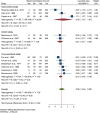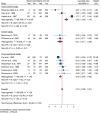Association between ovalocytosis and Plasmodium infection: a systematic review and meta-analysis
- PMID: 37137935
- PMCID: PMC10156661
- DOI: 10.1038/s41598-023-34170-3
Association between ovalocytosis and Plasmodium infection: a systematic review and meta-analysis
Abstract
Reports of an association between ovalocytosis and protection against Plasmodium infection are inconsistent. Therefore, we aimed to synthesise the overall evidence of the association between ovalocytosis and malaria infection using a meta-analysis approach. The systematic review protocol was registered with PROSPERO (CRD42023393778). A systematic literature search of the MEDLINE, Embase, Scopus, PubMed, Ovid, and ProQuest databases, from inception to 30 December 2022, was performed to retrieve studies documenting the association between ovalocytosis and Plasmodium infection. The quality of the included studies was assessed using the Newcastle-Ottawa Scale. Data synthesis included a narrative synthesis and a meta-analysis to calculate the pooled effect estimate (log odds ratios [ORs]) and 95% confidence intervals (CIs) using the random-effects model. Our database search retrieved 905 articles, 16 of which were included for data synthesis. Qualitative synthesis revealed that over half of the studies showed no association between ovalocytosis and malaria infections or severity. Furthermore, our meta-analysis demonstrated no association between ovalocytosis and Plasmodium infection (P = 0.81, log OR = 0.06, 95% CI - 0.44 to 0.19, I2: 86.20%; 11 studies). In conclusion, the meta-analysis results demonstrated no association between ovalocytosis and Plasmodium infection. Hence, the role of ovalocytosis in relation to protection against Plasmodium infection or disease severity should be further investigated in larger prospective studies.
© 2023. The Author(s).
Conflict of interest statement
The authors declare no competing interests.
Figures






Similar articles
-
Alteration of Platelet Count in Patients with Severe Non-Plasmodium falciparum Malaria: A Systematic Review and Meta-Analysis.Biology (Basel). 2021 Dec 5;10(12):1275. doi: 10.3390/biology10121275. Biology (Basel). 2021. PMID: 34943190 Free PMC article. Review.
-
Prevalence of and risk factors for Plasmodium spp. co-infection with hepatitis B virus: a systematic review and meta-analysis.Malar J. 2020 Oct 15;19(1):368. doi: 10.1186/s12936-020-03428-w. Malar J. 2020. PMID: 33059662 Free PMC article.
-
Association between Rhesus Blood Groups and Malaria Infection: A Systematic Review and Meta-Analysis.Trop Med Infect Dis. 2023 Mar 25;8(4):190. doi: 10.3390/tropicalmed8040190. Trop Med Infect Dis. 2023. PMID: 37104316 Free PMC article. Review.
-
Alteration of ceruloplasmin in patients with malaria: a systematic review and meta-analysis of observational studies.Malar J. 2024 Nov 21;23(1):353. doi: 10.1186/s12936-024-05156-x. Malar J. 2024. PMID: 39574108 Free PMC article.
-
Prevalence and proportion estimate of asymptomatic Plasmodium infection in Asia: a systematic review and meta-analysis.Sci Rep. 2023 Jun 27;13(1):10379. doi: 10.1038/s41598-023-37439-9. Sci Rep. 2023. PMID: 37369862 Free PMC article.
Cited by
-
Rapid change in red cell blood group systems after the main Out of Africa of Homo sapiens.Sci Rep. 2025 Jan 23;15(1):1597. doi: 10.1038/s41598-024-83023-0. Sci Rep. 2025. PMID: 39848961 Free PMC article.
References
-
- WHO. World malaria report 2022. Available from: https://www.who.int/teams/global-malaria-programme/reports/world-malaria.... Accessed 5 February 2023.
Publication types
MeSH terms
LinkOut - more resources
Full Text Sources
Medical

